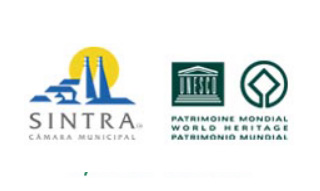Pena National Palace, in the historical town of Sintra and part of the Pena park, represents one of the best expressions in the world of 19th-century architectural Romanticism.
On 7 July 2007, it was selected as one of the seven wonders of Portugal.
It was the first Romantic palace in Europe, having been built about 30 years before the charismatic Schloss Neuschwanstein, in Bavaria.
![]() The palace and park were designed and constructed as a single entity. From the palace, visitors look out on a mantle of greenery that covers over 200 hectares Pena Park. This park offers wonderful walks, with numerous garden constructions.
There are bridges and grottoes, garden seats, pergolas and fountains, small houses to accommodate guards and other staff. There are also greenhouses and nursery gardens with camellias, rhododendrons and unusual, very rare climbing roses. Among the sculptures is the one of the warrior, which can be seen from the palace, who seems to be saying he is there to protect and guard it. The ponds near the exit to the Moorish Castle are likewise picturesque and pleasant, surrounded by a great hedge of tree ferns.
Pena Park is now considered to have the richest and most unusual collection of tree species in Europe, which no longer exist in many of the other countries and continents from which they originate.
The palace and park were designed and constructed as a single entity. From the palace, visitors look out on a mantle of greenery that covers over 200 hectares Pena Park. This park offers wonderful walks, with numerous garden constructions.
There are bridges and grottoes, garden seats, pergolas and fountains, small houses to accommodate guards and other staff. There are also greenhouses and nursery gardens with camellias, rhododendrons and unusual, very rare climbing roses. Among the sculptures is the one of the warrior, which can be seen from the palace, who seems to be saying he is there to protect and guard it. The ponds near the exit to the Moorish Castle are likewise picturesque and pleasant, surrounded by a great hedge of tree ferns.
Pena Park is now considered to have the richest and most unusual collection of tree species in Europe, which no longer exist in many of the other countries and continents from which they originate.
http://www.sintraromantica.net/en/monuments/national-palace-of-pena#sigFreeIde5a9137be2
The Palace of Pena stands atop a rocky peak, which is the second highest point in the Sintra hills (the only place higher than the palace itself is the Cruz Alta, 528 metres above sea level). The palace is situated in the eastern part of the Park of Pena, which one has to pass through to reach the steep ramp built by the Baron of Eschwege that provides access to the castle-like building. The palace itself is composed of two wings: the former Manueline monastery of the Order of St. Jerome and the wing built in the 19th century by King Ferdinand II. These wings are ringed by a third architectural structure that is a fantasised version of an imaginary castle, whose walls one can walk around and which comprises battlements, watchtowers, an entrance tunnel and even a drawbridge.
In 1838, King Ferdinand II acquired the former Hieronymite monastery of Our Lady of Pena, which had been built by King Manuel I in 1511 on the top of the hill above Sintra and had been left unoccupied since 1834 when the religious orders were suppressed in Portugal. The monastery consisted of the cloister and its outbuildings, the chapel, the sacristy and the bell tower, which today form the northern section of the Palace of Pena, or the Old Palace as it is known.
King Ferdinand began by making repairs to the former monastery, which, according to the historical sources of that time, was in very bad condition. He refurbished the whole of the upper floor, replacing the fourteen cells used by the monks with larger-sized rooms and covering them with the vaulted ceilings that can still be seen today. In roughly 1843, the king decided to enlarge the palace by building a new wing (the New Palace) with even larger rooms (the Great Hall is a good example of this), ending in a circular tower next to the new kitchens. The building work was directed by the Baron of Eschwege.
The 1994 repair works restored the original colours of the Palace’s exterior: pink for the former monastery and ochre for the New Palace.
In transforming a former monastery into a castle-like residence, King Ferdinand showed that he was heavily influenced by German romanticism, and that he probably found his inspiration in the Stolzenfels and Rheinstein castles on the banks of the Rhine, as well as Babelsberg Palace in Potsdam. These building works at the Palace of Pena ended in the mid-1860s, although further work was also undertaken at later dates for the decoration of the interiors.
King Ferdinand also ordered the Park of Pena to be planted in the Palace’s surrounding areas in the style of the romantic gardens of that time, with winding paths, pavilions and stone benches placed at different points along its routes, as well as trees and other plants originating from the four corners of the earth. In this way, the king took advantage of the mild and damp climate of the Sintra hills to create an entirely new and exotic park with over five hundred different species of trees.
The most fascinating construction in the Park of Pena is the Chalet of the Countess of Edla, also known as the House of Indulgence (Casa do Regalo), which is located at the park’s western end. Its building was commissioned by King Ferdinand II and his future second wife, Elise Hensler (the Countess of Edla), as a private summer residence. It is a two-storey building with a very scenic appearance, denoting a distinctive alpine inspiration and maintaining an expressive visual relationship with the Palace.
The Palace of Pena was designated a National Monument in 1910 and forms part of the Cultural Landscape of Sintra, which has been classified by UNESCO as World Heritage since 1995.
In 2013, the Palace was integrated into the Network of European Royal Residences.
Opening Hours and Entrance Fees:
http://www.parquesdesintra.pt/planear-a-sua-visita/horarios-e-precos/
Estrada da Pena
2710-609 Sintra
Tel.: 21 923 73 00 / 21 923 73 36
E-mail: info@parquesdesintra.pt / comercial@parquesdesintra.pt
www.parquesdesintra.pt
Palácio Nacional da Pena
38º 47’ 16,45” N
9º 23’ 15,35” W


 Português
Português
 English (UK)
English (UK)







